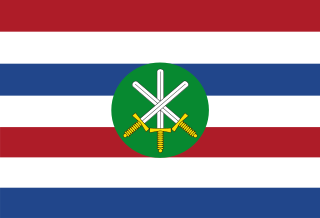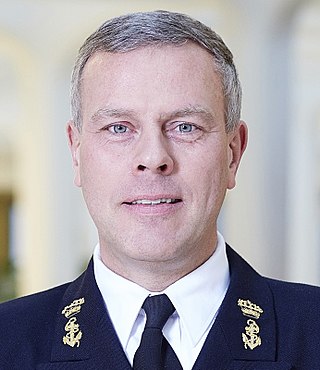
The Netherlands Armed Forces are the military services of the Kingdom of the Netherlands. The core of the armed forces consists of the four service branches: the Royal Netherlands Navy, the Royal Netherlands Army, the Royal Netherlands Air Force and the Royal Netherlands Marechaussee. The service branches are supplemented by various joint support organisations. In addition, local conscript forces exist on the Dutch Caribbean islands of Aruba (AruMil) and Curaçao (CurMil). These operate under the auspices of the Royal Netherlands Navy and the Netherlands Marine Corps. The armed forces are organisationally part of the Ministry of Defence.

Petrus Jozef Sietse "Piet" de Jong was a Dutch politician and naval officer who served as Prime Minister of the Netherlands from 1967 to 1971. He was a member of the now-defunct Catholic People's Party (KVP), later merged into the current-day Christian Democratic Appeal (CDA).

The Royal Netherlands Army is the land branch of the Netherlands Armed Forces. Though the Royal Netherlands Army was raised on 9 January 1814, its origins date back to 1572, when the Staatse Leger was raised making the Dutch standing army one of the oldest in the world. It fought in the Napoleonic Wars, World War II, the Indonesian War of Independence, and the Korean War, and served with NATO on the Cold War frontiers in West Germany from the 1950s to the 1990s.

The Den Uyl cabinet was the executive branch of the Dutch Government from 11 May 1973 until 19 December 1977. The cabinet was formed by the social-democratic Labour Party (PvdA), the christian-democratic Catholic People's Party (KVP) and Anti-Revolutionary Party (ARP), the progressive Political Party of Radicals (PPR) and the social-liberal Democrats 66 (D'66) after the election of 1972. The cabinet was a Centre-left grand coalition and had a substantial majority in the House of Representatives with Labour Leader Joop den Uyl serving as Prime Minister. Prominent Catholic politician Dries van Agt, the Minister of Justice from the previous cabinet, served as Deputy Prime Minister until his resignation. Prominent Protestant politician Gaius de Gaay Fortman the Minister of the Interior assumed the office of Deputy Prime Minister on 8 September 1977.

Willem Johan Cornelis, Ridder Huijssen van Kattendijke was a career officer of the Royal Dutch Navy and a politician. As an officer, he reached the rank of Commander. He was Dutch Naval Minister from 1861 to 1866, and interim Dutch Foreign Minister in 1864.
The Military ranks of the Netherlands armed forces are the military insignia used by the armed forces of the Netherlands.

Korps Speciale Troepen was a Royal Netherlands East Indies Army (KNIL) special forces unit that was established for deployment against the Indonesian revolutionaries during the Indonesian National Revolution. It was formed in 1948 with the Depot Speciale Troepen at its core and disbanded alongside the Royal Netherlands East Indies Army in 1950, by which time it had been renamed to the Regiment Speciale Troepen. The DST consisted of about 570 men at its establishment in 1945 and had a precursor in the Korps Insulinde that conducted clandestine operations during the Japanese occupation of the Dutch East Indies. In June 1949, 250 men of the 1st Parachute Company were integrated into the Corps. The KST, which would reach a maximum strength of 1250 men, was composed of Dutch war volunteers (OVWs), Eurasians and native soldiers, including Moluccans. The present day Korps Commandotroepen of the Royal Netherlands Army is considered a continuation of the RST.

The Ministry of Defence is the Dutch ministry responsible for the armed forces of the Netherlands and veterans' affairs. The ministry was created in 1813 as the Ministry of War and in 1928 was combined with the Ministry of the Navy. After World War II in the ministries were separated again, in this period the Minister of War and Minister of the Navy were often the same person and the state secretary for the Navy was responsible for daily affairs of the Royal Netherlands Navy. In 1959 the ministries were merged once again. The ministry is headed by the Minister of Defence, currently Kajsa Ollongren, assisted by the Chief of the Defence, Onno Eichelsheim since April 2021.

Ton van Loon is a commander from the Netherlands. He is a Lieutenant General employed by NATO who took control of the International Security Assistance Force (ISAF), Regional Command South (RC-S) on November 1, 2006, until May 1, 2007. From April 13, 2010, until September 25, 2013, he commanded I. German/Dutch Corps. He is married and has two children.

Petrus Johannes Mathias "Peter" van Uhm is a retired Royal Netherlands Army general. He served as Chief of Defence of the Armed forces of the Netherlands from 17 April 2008 until 28 June 2012. He previously served as the Commander of the Royal Netherlands Army from 5 September 2005 until 13 March 2008.

The chief of defence is the highest-ranking military officer in the armed forces of the Netherlands and is the principal military advisor to the minister of defence. On behalf of the minister of defence, he is responsible for operational policy, strategic planning and for preparing and executing military operations carried out by the armed forces. The chief of defence is in charge of the central staff and is the direct commanding officer of all the commanders of the branches of the armed forces. In this capacity, the chief of defence directs all the activities of the Royal Netherlands Army, the Royal Netherlands Navy and Royal Netherlands Air Force. He is also in charge of the Royal Netherlands Marechaussee, when it is operating under the responsibility of the minister of defence.

Robert Antonius Cornelis "Rob" Bertholee is a retired lieutenant general of the Royal Netherlands Army who served the head of the General Intelligence and Security Service (AIVD) from 2011 to 2018. He previously was Commander of the Royal Netherlands Army from 2008 to 2011. Born in Haarlem, Bertholee is married and has one daughter.

The Commander of the Royal Netherlands Navy (CZsk) is the highest-ranking officer of the Royal Netherlands Navy. The CZsk reports directly to the Chief of the Netherlands Defence Staff.

The Commander of the Royal Netherlands Air Force (C-LSK) is the highest-ranking officer of the Royal Netherlands Air Force. He reports directly to the Chief of the Defence (CDS).

Vice admiral Matthieu Borsboom is a retired Royal Netherlands Navy officer who is a former Commander of the Royal Netherlands Navy and Admiral Benelux, and has served with the International Security Assistance Force in Afghanistan.

Thomas Antonius Middendorp is a retired general of the Royal Netherlands Army. He served as Chief of Defence of the Armed forces of the Netherlands from 28 June 2012 until 3 October 2017. He previously served as the commander of Task Force Uruzgan part of the International Security Assistance Force from 2 February 2009 until 3 August 2009.

Martin Wijnen is a Dutch Lieutenant-general. He was the Commander of 43 Mechanized Brigade and is now the commander of the Royal Netherlands Army.

Robert Peter Bauer is a Dutch lieutenant admiral in the Royal Netherlands Navy, currently serving as the Chair of the NATO Military Committee since June 2021, after succeeding Air Chief Marshal Stuart Peach. Bauer previously served as the Chief of Defence from October 2017 to April 2021, and as the Vice Chief of Defence of the Armed forces of the Netherlands from 1 September 2015 to 13 July 2017. Bauer was also involved in anti-terrorist and anti-piracy operations in the Mediterranean Sea, the and in the Horn of Africa.

Onno Eichelsheim is a general in the Royal Netherlands Air Force serving as Chief of Defence of the Netherlands Armed Forces since 15 April 2021. Prior to his post, he served as the Vice Chief of Defence from 1 July 2019 to 8 March 2021.
Korps Insulinde was a Dutch special forces unit established in March 1942 in British Ceylon, present-day Sri Lanka. The unit, originally called the Netherland Special Operations, emerged from the Princess Irene Brigade alongside No. 2 (Dutch) Troop of the No. 10 (Inter-Allied) Commando. The Korps Insulinde fought during World War II against the Japanese occupiers of the Dutch East Indies. The corps was commanded by Major Frits Mollinger of the Royal Netherlands East Indies Army (KNIL) and was stationed in Ceylon. It carried out a number of infiltration and intelligence operations in occupied Sumatra. The corps was disbanded between November 1945 and early March 1946.























